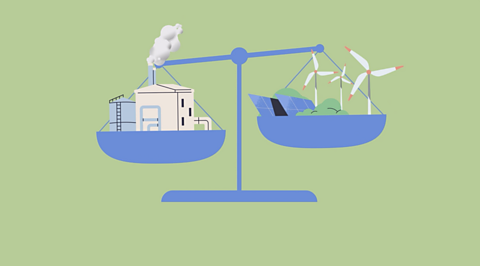What is renewable energy?
Renewable energy means using power from things in nature that never run out, like sunlight, wind, water, and heat from the Earth. Unlike fossil fuels, which are finiteSomething that has a limited number of uses before it is depleted. For example, oil is a finite resource. and contribute to climate change, renewable energy sources are sustainable, clean, and release minimal greenhouse gases. Using them is really important for combating climate change and making sure we have enough energy for the future.
Video: Renewable energy
We’ve made a lot of progress on renewable energy in Wales, and around the world too.
These are natural sources of energy that will never run out and that produce very little or no greenhouse gases. The ones that make climate change worse.
Up until the 18th century, most people lived in rural areas farming or producing goods on a small scale.
But when we began making things on a large scale, more people moved to cities and started working in factories and mines.We also began using a lot more energy, which came from fossil fuels like coal, oil and gas.
Fossil fuels are a finite resource, which means they will eventually run out altogether.
They also release a lot of greenhouse gases.
With these changes happening at different times in different countries, some have been burning fossil fuels longer than others.
The UK was one of the first, so you could argue we have a big responsibility to sort out the problem.
Renewable energy is very important for reducing greenhouse gases.
There are different benefits and limitations for each kind of renewable energy. So let’s have a look at them.
Solar power converts sunlight directly into energy.
It produces no greenhouse gases but does produce less energy in cloudy weather, and none at night, which means in Wales the energy produced changes a lot between summer and winter.
Giant turbines use wind power to create electricity.
Like solar, wind power produces no greenhouse gases.
There are debates about their effects on the view of the sea or countryside and they don’t produce energy when the wind isn’t blowing.
But luckily, Wales is often very windy!
Dams create hydroelectric power from the water flowing through them.
This process doesn’t make greenhouse gas emissions and is quite reliable but building them requires flooding a large area which can be bad for the local environment.
Dams are made largely of concrete, which produces greenhouse gases when it’s made. But they’d work well with the many rivers in Wales.
Biomass is any material made by plants and animals that we can convert into energy by burning it.
Burning biomass reduces what ends up in landfills. However, it does release low levels of greenhouse gases.
Land for wildlife or growing food will also be lost if it’s used to grow biomass fuel instead.
Hydrogen fuel cells use hydrogen and oxygen to generate electricity.
They don’t release any greenhouse gases.
However, producing hydrogen often involves using fossil fuels and it can be difficult to store.
Avoiding fossil fuels and using renewable energy will be a huge help in tackling climate change.
However, industries like steel manufacturing and mining still rely heavily on fossil fuels, and many people in Wales depend on jobs in these areas.
Fortunately though, more and more of our energy in Wales and across the UK comes from renewable sources.
In Pen y Cymoedd, for example, there’s a windfarm with more than 70 turbines.
Technology is also improving and the more time and attention we put into it, the better and cheaper it gets.
Solar power is now cheaper than producing it from fossil fuels.
And because solar power has improved so much, it now makes sense even in rainy climates like ours.
Why do we need more sustainable energy sources?
When people moved from living in the countryside to living in cities, industrialisation took place, which resulted in a surge of demand in energy. Different countries experienced industrialisation at different times, with the UK being one of the earliest adopters. South Wales was producing one third of global coal exports by 1900. The demand for energy was met by using fossil fuels such as wood, coal, oil and gas.
Fossil fuels are big polluters because they release carbon dioxide, and these types of energy sources are finite, meaning that our planet does not have a never-ending supply of them. As our population continued to grow, so did the demand for:
- factories
- cars
- different ways of travelling
- electrical goods
As a result, there is now a huge strain on our fossil fuel supplies, and our finite supply is reducing.
Given the environmental implications of fossil fuels, renewable energy plays a vital role in reducing greenhouse gas emissions.
Video: Renewable energy in action
In Wales and around the world, we’re getting more and more energy from renewable sources.
Let’s find out what that means and how you can help.
Burning fossil fuels like, oil, gas or coal to create energy releases loads of greenhouse gases.
These trap heat in the earth’s atmosphere, making climate change worse.
Renewable energy, on the other hand, comes from natural sources like wind or the sun.
It won’t run out, and produces very little to no greenhouse gases.
Across Wales, we heat castles with biomass, which burns materials from plants and animals for energy.
We power garden cafes with solar and we house one of Europe’s largest electricity generating waterwheels.
The Welsh government has even set up a renewable energy group to help Wales to get to net zero.
And there are loads of ways for us to contribute too.
If you can, find out where the energy you use comes from.
If it isn’t renewable, you could speak to the adults in your life about seeing if it’s possible to change where they get their energy from.
Think about how you get around as well, and if you can, try to choose forms of travel that use renewable energy.
Solar panels would make your energy more renewable, and it could be cheaper.
Of course, you don’t need to do it alone.
Collective action, or working together in groups, has an even greater impact.
How about joining a youth led organisation that’s focused on sustainability?
There are plenty across Wales.
A group can teach you more about the issue, makes the work more fun and can even make hard tasks seem easier.
Many hands make light work, after all.
You can also petition your local government by writing a letter or email, and getting signatures to support it, asking that they use more renewables and switch to technologies that can take full advantage, like electric buses.
With more renewable projects happening across Wales and all over the world, change is happening.
So get involved because we can all make a difference.
Activity: Examples of sustainable energy sources
Other examples of sustainable energy sources
Biomass converts organic materials into energy, reducing landfill waste.
Hydrogen fuel cells generates electricity from hydrogen and oxygen without emitting greenhouse gases.
Geothermal energy is heat that comes from deep inside the Earth. We can use this heat to make electricity or to warm buildings.
Renewable energy sources, like sunlight, wind, and water, are great because they don't run out like fossil fuels do. They don't pollute the air like coal or oil and using them creates jobs and helps our planet. But sometimes, they bring challenges. They don't always work when we need them, like when the wind isn't blowing or the sun isn't shining. Also, setting up renewable energy systems can cost a lot at first, and they might take up a lot of space. So, while they're great for the environment, they have some challenges.
Understanding the benefits and limitations of each renewable energy source is crucial, so that we can decide which is the best energy source for us.
Solar power
| Advantages | Disadvantages |
|---|---|
| Sun power is endless and clean, producing no pollution. It is easy to maintain and has low operating costs. | Energy production changes acording to weather conditions, particularly in places Wales where sunlight varies significantly between seasons. |
Wind power
| Advantages | Disadvantages |
|---|---|
| Can be built on land and bring economic benefits to the area as jobs are created. | There is a debate regarding their visual impact. During calm weather periods energy production may dip, though Wales benefits from consistent wind. |
Hydroelectric power
| Advantages | Disadvantages |
|---|---|
| Uses flowing water, which is a constantly replenished resource. Reliable and long-lasting, with some systems helping to store energy. | The construction of dams and barrages may seriously affect local environments through flooding. It could also affect where wading birds A bird with long legs that finds it food in water. feed or fish spawn A mass of eggs laid in water.. |
Biomass
| Advantages | Disadvantages |
|---|---|
| Relies on organic waste materials, which is readily available in every household. Reduces pollution and landfill waste. | Releases low levels of greenhouse gases such as methane. May compete with wildlife for land or food production. |
Hydrogen fuel cells
| Advantages | Disadvantages |
|---|---|
| They use fuel more efficiently than traditional engines, getting more energy from the same amount of fuel. They produce zero emissions, only water vapour and heat, causing no pollution. | Production of the cells may initially rely on fossil fuels. Hydrogen fuel cell technology is currently expensive to produce. Maintaining and storing the cells safely can be problematic. |
Geothermal energy
| Advantages | Disadvantages |
|---|---|
| Since the heat comes from within the Earth, it's always available for use. | Geothermal power plants need hot rocks or water near the Earth's surface and these are not found in every location. |
Activity: Examples of renewable energy in Wales
In Wales, you can find lots of examples of renewable energy sources. We use wind power from offshore wind farms in the sea and onshore wind turbines on land. Rivers and reservoirs are used for hydroelectric power stations. You'll also see solar panels on rooftops and in fields.
The role of renewable energy in shaping our future
Renewable energy, like solar and wind power, plays a huge role in our lives, even if we don't always notice it. It's about the different kinds of energy we use to light up our homes, run our schools, and basically power our world.
So, why does this matter? It means we get to breathe cleaner air, which is better for our health and the planet's future. It also opens up opportunities for new jobs and innovative technologies. Renewable energy is shaping our world in ways that are good for us now and for future generations.
You can help, by making small changes at home, like using energy-saving light bulbs, being mindful of wasting water and turning off devices when you're not using them. You can also keep exploring and learning about new green technologies and share your discoveries with your family and friends.
Quiz
More on Energy and transport
Find out more by working through a topic
- count3 of 3

- count1 of 3
